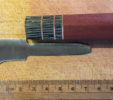- Joined
- Jun 3, 2019
- Messages
- 2,714
I need your help/advice here.....
I am still struggling with one aspect of construction of Wa Handles. Not the assembly, but rather the initial creation and shaping of the segments that then get glued up into the stack. For example, in the below picture:

the three segments (separated by copper spacers) were individually cut (similar appearances for the but end of the handle). for this stack to look right (and for secure gluing) , the top and bottom of these pieces need to be 1) flat, and 2) parallel to each other. On this particular stack, I think I got really lucky. But before this one, and especially yesterday, getting this pre-glue geometry right, especially with these small pieces, is NOT easy.
I have tried parallel cuts on the bandsaw with careful hand-sanding on a flat plate (does not work consistently), I have tried sanding on my grinder with jigs in place to define perpendicular to the belt and another jig/block to apply even pressure to the block - that does not work consistently. I have tried the careful hand sanding to correct the messed up blocks - THAT does not work consistently. Yesterday I struggled with four different blocks of nice African Blackwood .... and I sit here not knowing if they are salvageable
 .
.
I know that several people have commented on using a disk sander to flatten scales ... but I have a small space and disks produce a lot of dust, AND it is not clear to me that one can be used to reliably create the mutually perpendicular sides.
I keep coming back to the thought that what I need is a mini-mill. Problems there are cost, and I dont really have space in my shop to permanently set a mini-mill .... but if I have to, I will find a way .
.
Am I missing another option? Am I wrong in thinking that a mini-mill will accomplish what I want it to do here (in addition to other work, like better drilling on hardened steel and shaping/slotting on bolsters and slotting the blade ends of Wa handles???? My four deformed blocks of African Blackwood eagerly await your input!
I am still struggling with one aspect of construction of Wa Handles. Not the assembly, but rather the initial creation and shaping of the segments that then get glued up into the stack. For example, in the below picture:

the three segments (separated by copper spacers) were individually cut (similar appearances for the but end of the handle). for this stack to look right (and for secure gluing) , the top and bottom of these pieces need to be 1) flat, and 2) parallel to each other. On this particular stack, I think I got really lucky. But before this one, and especially yesterday, getting this pre-glue geometry right, especially with these small pieces, is NOT easy.
I have tried parallel cuts on the bandsaw with careful hand-sanding on a flat plate (does not work consistently), I have tried sanding on my grinder with jigs in place to define perpendicular to the belt and another jig/block to apply even pressure to the block - that does not work consistently. I have tried the careful hand sanding to correct the messed up blocks - THAT does not work consistently. Yesterday I struggled with four different blocks of nice African Blackwood .... and I sit here not knowing if they are salvageable
I know that several people have commented on using a disk sander to flatten scales ... but I have a small space and disks produce a lot of dust, AND it is not clear to me that one can be used to reliably create the mutually perpendicular sides.
I keep coming back to the thought that what I need is a mini-mill. Problems there are cost, and I dont really have space in my shop to permanently set a mini-mill .... but if I have to, I will find a way
Am I missing another option? Am I wrong in thinking that a mini-mill will accomplish what I want it to do here (in addition to other work, like better drilling on hardened steel and shaping/slotting on bolsters and slotting the blade ends of Wa handles???? My four deformed blocks of African Blackwood eagerly await your input!
